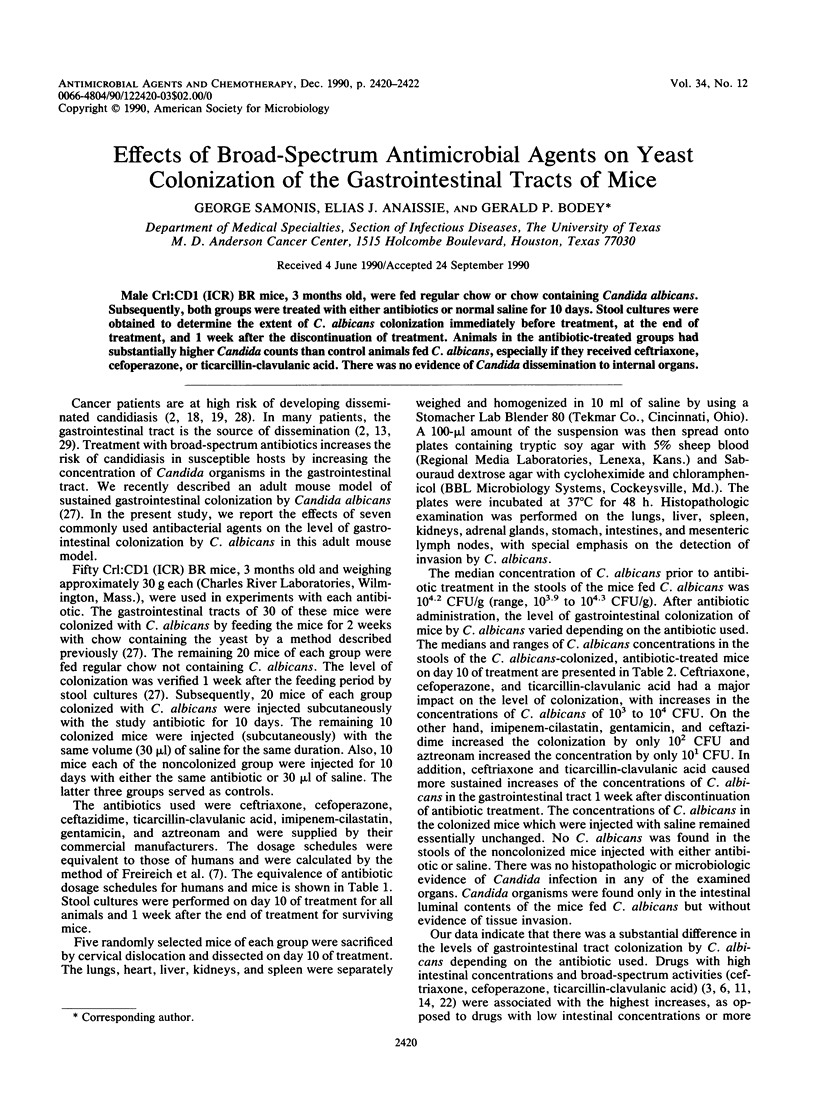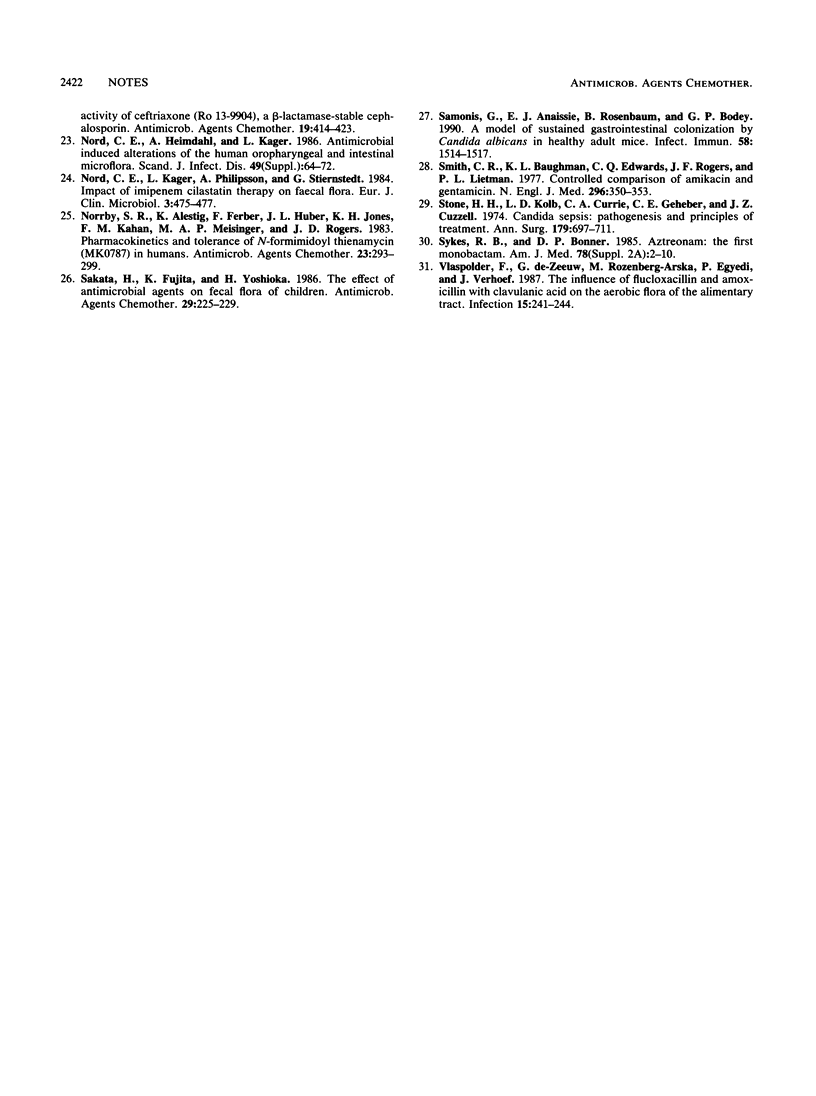Abstract
Male Crl:CD1 (ICR) BR mice, 3 months old, were fed regular chow or chow containing Candida albicans. Subsequently, both groups were treated with either antibiotics or normal saline for 10 days. Stool cultures were obtained to determine the extent of C. albicans colonization immediately before treatment, at the end of treatment, and 1 week after the discontinuation of treatment. Animals in the antibiotic-treated groups had substantially higher Candida counts than control animals fed C. albicans, especially if they received ceftriaxone, cefoperazone, or ticarcillin-clavulanic acid. There was no evidence of Candida dissemination to internal organs.
Full text
PDF


Selected References
These references are in PubMed. This may not be the complete list of references from this article.
- Bodey G. P. Candidiasis in cancer patients. Am J Med. 1984 Oct 30;77(4D):13–19. [PubMed] [Google Scholar]
- Bär W., Welling G. W., Kurrle E. Effects of selective oral antimicrobial prophylaxis and systemic antibiotics on the fecal flora and fecal beta-aspartylglycine concentration in patients with acute leukemia. APMIS. 1989 Aug;97(8):705–714. doi: 10.1111/j.1699-0463.1989.tb00466.x. [DOI] [PubMed] [Google Scholar]
- Donowitz G. R., Mandell G. L. Drug therapy. Beta-lactam antibiotics (2). N Engl J Med. 1988 Feb 25;318(8):490–500. doi: 10.1056/NEJM198802253180806. [DOI] [PubMed] [Google Scholar]
- Freireich E. J., Gehan E. A., Rall D. P., Schmidt L. H., Skipper H. E. Quantitative comparison of toxicity of anticancer agents in mouse, rat, hamster, dog, monkey, and man. Cancer Chemother Rep. 1966 May;50(4):219–244. [PubMed] [Google Scholar]
- Giuliano M., Barza M., Jacobus N. V., Gorbach S. L. Effect of broad-spectrum parenteral antibiotics on composition of intestinal microflora of humans. Antimicrob Agents Chemother. 1987 Feb;31(2):202–206. doi: 10.1128/aac.31.2.202. [DOI] [PMC free article] [PubMed] [Google Scholar]
- Hoepelman I. M., Rozenberg-Arska M., Verhoef J. Comparative study of ceftriaxone monotherapy versus a combination regimen of cefuroxime plus gentamicin for treatment of serious bacterial infections: the efficacy, safety and effect on fecal flora. Chemotherapy. 1988;34 (Suppl 1):21–29. doi: 10.1159/000238643. [DOI] [PubMed] [Google Scholar]
- Kager L., Brismar B., Malmborg A. S., Nord C. E. Effect of aztreonam on the colon microflora in patients undergoing colorectal surgery. Infection. 1985 May-Jun;13(3):111–114. doi: 10.1007/BF01642868. [DOI] [PubMed] [Google Scholar]
- Kemmerich B., Lode H., Borner K., Belmega D., Jendroschek T., Koeppe P., Goertz G. Biliary excretion and pharmacokinetics of cefoperazone in humans. J Antimicrob Chemother. 1983 Jul;12(1):27–37. doi: 10.1093/jac/12.1.27. [DOI] [PubMed] [Google Scholar]
- Kennedy M. J., Volz P. A., Edwards C. A., Yancey R. J. Mechanisms of association of Candida albicans with intestinal mucosa. J Med Microbiol. 1987 Dec;24(4):333–341. doi: 10.1099/00222615-24-4-333. [DOI] [PubMed] [Google Scholar]
- Kennedy M. J., Volz P. A. Effect of various antibiotics on gastrointestinal colonization and dissemination by Candida albicans. Sabouraudia. 1985 Aug;23(4):265–273. doi: 10.1080/00362178585380391. [DOI] [PubMed] [Google Scholar]
- Meijer-Severs G. J., Joshi J. H. The effect of new broad-spectrum antibiotics on faecal flora of cancer patients. J Antimicrob Chemother. 1989 Oct;24(4):605–613. doi: 10.1093/jac/24.4.605. [DOI] [PubMed] [Google Scholar]
- Mulligan M. E., Citron D. M., McNamara B. T., Finegold S. M. Impact of cefoperazone therapy on fecal flora. Antimicrob Agents Chemother. 1982 Aug;22(2):226–230. doi: 10.1128/aac.22.2.226. [DOI] [PMC free article] [PubMed] [Google Scholar]
- Musial C. E., Cockerill F. R., 3rd, Roberts G. D. Fungal infections of the immunocompromised host: clinical and laboratory aspects. Clin Microbiol Rev. 1988 Oct;1(4):349–364. doi: 10.1128/cmr.1.4.349. [DOI] [PMC free article] [PubMed] [Google Scholar]
- Myerowitz R. L., Pazin G. J., Allen C. M. Disseminated candidiasis. Changes in incidence, underlying diseases, and pathology. Am J Clin Pathol. 1977 Jul;68(1):29–38. doi: 10.1093/ajcp/68.1.29. [DOI] [PubMed] [Google Scholar]
- Neu H. C., Labthavikul P. Antibacterial activity and beta-lactamase stability of ceftazidime, an aminothiazolyl cephalosporin potentially active against Pseudomonas aeruginosa. Antimicrob Agents Chemother. 1982 Jan;21(1):11–18. doi: 10.1128/aac.21.1.11. [DOI] [PMC free article] [PubMed] [Google Scholar]
- Nord C. E., Heimdahl A., Kager L. Antimicrobial induced alterations of the human oropharyngeal and intestinal microflora. Scand J Infect Dis Suppl. 1986;49:64–72. [PubMed] [Google Scholar]
- Nord C. E., Kager L., Philipson A., Stiernstedt G. Impact of imipenem/cilastatin therapy on faecal flora. Eur J Clin Microbiol. 1984 Oct;3(5):475–477. doi: 10.1007/BF02017379. [DOI] [PubMed] [Google Scholar]
- Norrby S. R., Alestig K., Ferber F., Huber J. L., Jones K. H., Kahan F. M., Meisinger M. A., Rogers J. D. Pharmacokinetics and tolerance of N-formimidoyl thienamycin (MK0787) in humans. Antimicrob Agents Chemother. 1983 Feb;23(2):293–299. doi: 10.1128/aac.23.2.293. [DOI] [PMC free article] [PubMed] [Google Scholar]
- Sakata H., Fujita K., Yoshioka H. The effect of antimicrobial agents on fecal flora of children. Antimicrob Agents Chemother. 1986 Feb;29(2):225–229. doi: 10.1128/aac.29.2.225. [DOI] [PMC free article] [PubMed] [Google Scholar]
- Samonis G., Anaissie E. J., Rosenbaum B., Bodey G. P. A model of sustained gastrointestinal colonization by Candida albicans in healthy adult mice. Infect Immun. 1990 Jun;58(6):1514–1517. doi: 10.1128/iai.58.6.1514-1517.1990. [DOI] [PMC free article] [PubMed] [Google Scholar]
- Smith C. R., Baughman K. L., Edwards C. Q., Rogers J. F., Lietman P. S. Controlled comparison of amikacin and gentamicin. N Engl J Med. 1977 Feb 17;296(7):349–353. doi: 10.1056/NEJM197702172960701. [DOI] [PubMed] [Google Scholar]
- Stone H. H., Kolb L. D., Currie C. A., Geheber C. E., Cuzzell J. Z. Candida sepsis: pathogenesis and principles of treatments. Ann Surg. 1974 May;179(5):697–711. doi: 10.1097/00000658-197405000-00024. [DOI] [PMC free article] [PubMed] [Google Scholar]
- Sykes R. B., Bonner D. P. Aztreonam: the first monobactam. Am J Med. 1985 Feb 8;78(2A):2–10. doi: 10.1016/0002-9343(85)90196-2. [DOI] [PubMed] [Google Scholar]
- Vlaspolder F., de Zeeuw G., Rozenberg-Arska M., Egyedi P., Verhoef J. The influence of flucloxacillin and amoxicillin with clavulanic acid on the aerobic flora of the alimentary tract. Infection. 1987 Jul-Aug;15(4):241–244. doi: 10.1007/BF01644122. [DOI] [PubMed] [Google Scholar]
- de Vries-Hospers H. G., Welling G. W., Swabb E. A., van der Waaij D. Selective decontamination of the digestive tract with aztreonam: a study of 10 healthy volunteers. J Infect Dis. 1984 Nov;150(5):636–642. doi: 10.1093/infdis/150.5.636. [DOI] [PubMed] [Google Scholar]


